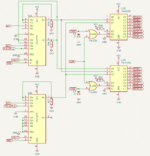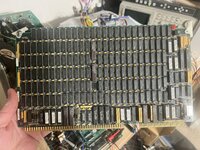I have a different theory about how the refresh mechanism works:
The refresh mechanism the 512K generates 256 addresses (RA0-RA7) to the lower 16-bit address word (CAS0, Row G of 8 41256´s ICs) first. That takes less than 4 ms.
Then, RA8 goes high and generates another 256 addresses (RA0-RA7), which are latched to the higher 16-bit address word (CAS1, Row F of 8 74256´s).
So every 41256 (1 bit) is refreshed at least every 4 ms, but from the new RAM IC (16 bits) perspective, it 'sees' 512 addresses generated sequentially (RA0-RA8) in less than 8 ms!
That could not be a coincidence, probably the designers of the 512K had in mind at some point to use DRAM IC´s of 512 refresh cycles, so they came up with a mechanism that would work for both types of RAM IC.
I made some errors in my previous post, please discard it!
Here is what I want really to say:
I have a different theory about how the refresh mechanism works:
The refresh mechanism in the 512K generates 256 addresses (RA0-RA7) to refresh the lower and higher 16-bit data (Row G and F of 8 41256´s ICs) at the same time. This takes less than 4 ms. Everything is clear up to this point right?
But from a RAM IC of 9-bit address with 512 refresh cycles (RA0-R8) perspective, things are seen like this:
Somehow RA8 must be toggling at least every 4 ms in perfect sync with the restart of the refresh counter (RA0-RA7).
So the new RAM IC (16 bits data, 9 address bits) "sees" 512 addresses generated sequentially (first the lower or higher 16-bit data for 4 ms, then the other lower or higher 16-bit data RA0-RA8 for another 4 ms) in less than 8 ms!
The way the refresh is done could not be a coincidence. Probably the designers of the 512K had in mind at some point to use DRAM ICs with 512 refresh cycles, so they came up with a mechanism that would work for both types of RAM IC.
Toggling of RA8 solely due to CPU or video access wouldn't be enough to accomplish a complete refresh of its 512 rows. It is simply not feasible. For sure, many rows would not be refreshed within an 8 ms period, and data corruption would occur instantly
I have let the Mac run with the OS for up to 30 minutes, and no hanging or crashing occurred.


